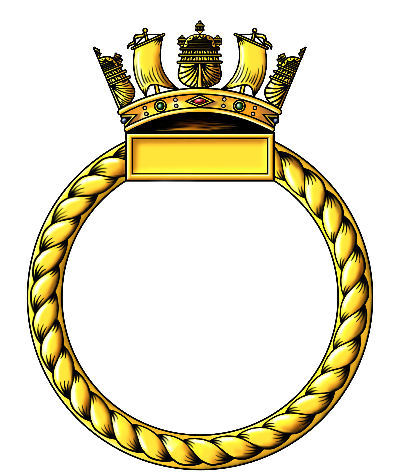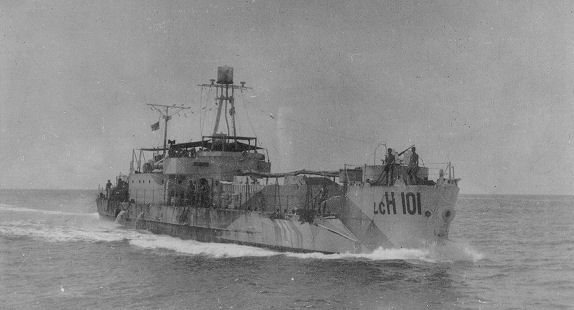Landing Craft Headquarters Ship

No badge issued for this vessel
Battle Honours
Burma 1945
Specifications
Builder: New Jersey Shipbuilding Corp., Barber, New Jersey, United States
Displacement:
Light, 216 t.
Landing, 234 t.
Loaded, 389 t.
Length: 156 ft 5.5 in
Beam: 23 ft 3 in
Draught:
Light, 3' ft 1½ in mean
Landing, 2 ft' 8 in forward, 4 ft 10 in aft
Loaded, 5 ft 4 in forward, 5 ft 11 in aft
Propulsion: Two General Motors Quad units (4 General Motors 6051 series 71 Diesel engines per unit), driving twin variable pitch propellers, 2,320shp, 1 Quad unit per shaft.
Speed: 40 Knots
Cargo Capacity:
9 officers and 200 troops or 75 tons cargo - reduced by 50 troops after conversion.
Armament: Four single 20mm Oerlikon guns, mounted in tubs, one bow mounted, one mounted centrally on top of the superstructure aft of wheelhouse, one each port and starboard aft of superstructure.
Crew complement:
(LCI) 3 officers, 17 ratings
(LCH) 3 officers, 23 ratings
Commanding Officers
Lt. Basil Charles Matthiae RNVR 2.09.1944 - 10.01.1946
Related items
None
Reminiscences
None
Gallery
None
H.M.S. LCH-261

No images exist of LCH 261, this is her Sister ship LCH 101. Photo cutesy of Mr. Tony Bull
Early history
Ordered and delivered as a Landing Craft Infantry (Large) for the US Navy she was built by the New Jersey Shipbuilding Corp., Barber, New Jersey. She was ordered on August 29th 1942, her keel was laid down on October 13th 1942 and she was launched on March 19th 1943. She was transferred to the Royal Navy under the lend-lease agreement on March 27th 1943 and commissioned as LCI(L) 261 at Staten Island, New York.
After completing her short work-up she sailed to US Naval Base Norfolk, Virginia for repairs and alterations. Over the next two months she underwent the installation of plastic armour, sounding equipment, sponsons and flareplates, repairs to her hull, electrical system and main engines; she also received a replacement winch and pinace. Before leaving Norfolk she was degaussed and calibrated at the Sewalls Point Magnetic Range, and visited the US Naval Ammunition Depot, St. Juliens Creek, Virginia, to embark small arms and gun ammunition.
LCI(L) 261 sailed from Norfolk for Gibraltar, via Bermuda, on May 12th. with 19 other (LCI(L), No.s 136, 257, 259, 261, 278, 280, 281, 282, 284, 286, 289, 292, 294, 303. 308, 311, 313, 316, & 319. The crossing took approximately 30 days.
Operations in the Mediterranean
During the next few months LCI(L) 261 appears to have been operating in the Med....12th LCI(L) flotilla ?
Reallocated to the East Indies Fleet
On release from Mediterranean operations the 12th LCI(L) flotilla was reallocated to the Eastern Fleet and sailed for Bombay, India, calling at Port Said and Aden. They reached Aden on Friday, November 19th after a stormy crossing of the Red Sea. After refuelling the flotilla continued on to Bombay, arriving there on December 3rd 1943. The flotilla was to remain at Bombay in the training role, operating with the RN Landing Craft Signals and Navigation Training Establishment HMS BRAGANZA III.
Conversion to a Headquarters Ship
Early in 1944 LCI(L) 261 was converted into an LCH, Landing Craft Headquarters at Bombay. She underwent a period of modification which involved turning part of the troop decks into operations rooms and wireless offices, the installation of additional British command and control and communications equipment; 6 x Army No. 22 Radio sets; 6 X CDG, B28 receivers; 1 X CDF, B29 receiver. Echo Sounding type 763; 8 type visual signals (lanterns and torches); Type 970 Radar for navigation and control of assault craft; Outfit QH (Gee Hyperbolic Radio Navaid) 1 x TCS Transmitter. A tripod foremast was added to mount the additional aerials. In addition, single cabins were installed to accommodate assault force staff officers when embarked. When completed her troop carrying capacity was reduced by 50.
Sometime in June 1944 the flotilla personnel moved into the Royal Marines Camp at Chembur on the outskirts of Bombay where they were to remain until November 1944 when the Eastern Fleet was restructured and renamed the East Indies Fleet; under this new organisation the flotilla relocated to Chittagong which was to become their main base of operations for the fleets Amphibious Assault Force, Force ‘W’. After the D-Day landings plans were made to relocate large numbers of Major Landing Craft from the UK to the Eastern theatre under the code name ‘APPIAN’. Convoys of craft, referred to as ‘Flights’, sailed for India and Ceylon calling at Gibraltar, Oran, Malta, Port Said, Aden, and Bombay; the first Flight, ‘A’, sailed on November 15th 1944. .
At this time the flotilla is believed to have been renumbered to 250 and consisted of LCI(L)s 114, 120, 173, 265, , 279, 285, 286, 304, 312, with three vessels converted into LCHs, numbers 261, 267 and 287.
Post War history
LCH 267 was returned to US custody on March 13th 1946 and struck from the Naval Register 25th April 1946. She was sold to the Indian Navy along with LCI(L) 173, 231, 244, 261, 265, 279, and 312 on this date.
Last modified: 23 February 2023
Primary information sources
Additional sources:
A Bit of a Different View -Life aboard Royal Navy LCI - by Fred Heffer, in "The Elsie Item" Issue Number 37. May, 2001.
NavSource Amphibious Photo Archive LCH-267 entry
www.uboat.net index of British and American
LCI(L)
navypedia.org RN AMPHIBIOUS SHIPS AND CRAFT
D-Day : The assault Allied Landing Craft and Ships
LCH specifications
Combined Operations Staff Notebook (1945)
Accessed July 2015
War Diaries: Found on
www.fold3.com
US Naval Ammunition Depot, St. Juliens Creek, Virginia,
U.S. Naval operating Base, Norfolk.
U.S. Naval operating Base, Bermuda.
U.S. Navy Yard, New York.
Admiralty War Diaries - various dates
Comments (0)